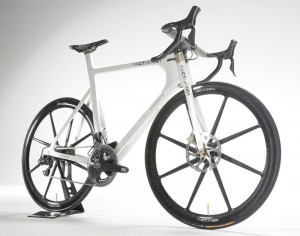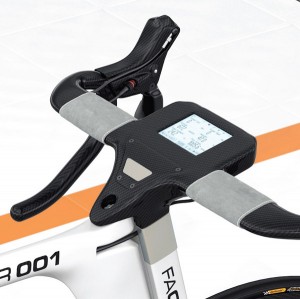 I have been getting quite a few emails lately about the Factor 001 bike from bf1 Systems. A couple of emailers cited this recent Autoblog post, which has apparently has stirred new interest on the web in the last week or so. Some of you may remember that I first mentioned the bike in December of 2007. At the time, I was skeptical about the design, but I was still glad to see a company from the motorsports industry investing design and engineering resources into the development of a bicycle. Regardless of my initial impression of the bike, I was certainly interested to hear what would come of the project. As of late 2009, custom fitted, Dura-Ace Di2 equipped Factor 001e bikes are available to order for £27,000 (about 40,000 USD) with the full electronics package (£22,000 for the Factor 001s base model). The production design does look better than the prototype that I posted a couple of years ago, but that $40K price tag is still a bit unbelievable to me.
I have been getting quite a few emails lately about the Factor 001 bike from bf1 Systems. A couple of emailers cited this recent Autoblog post, which has apparently has stirred new interest on the web in the last week or so. Some of you may remember that I first mentioned the bike in December of 2007. At the time, I was skeptical about the design, but I was still glad to see a company from the motorsports industry investing design and engineering resources into the development of a bicycle. Regardless of my initial impression of the bike, I was certainly interested to hear what would come of the project. As of late 2009, custom fitted, Dura-Ace Di2 equipped Factor 001e bikes are available to order for £27,000 (about 40,000 USD) with the full electronics package (£22,000 for the Factor 001s base model). The production design does look better than the prototype that I posted a couple of years ago, but that $40K price tag is still a bit unbelievable to me.
I shouldn’t be surprised though. Obviously this bike is not intended for everyone. It is certainly geared toward a narrow (and very affluent) segment of the custom made, high-end recreational bike market. The bike was not designed to comply with UCI requirements, a fact that one of the designers pointed out in the comments section of my 2007 post:
“The Factor 001 is not designed for UCI sanctioned mass-start races – Just as a car such as a Bugatti Veyron isn’t designed with FIA regulations in mind. So super-quick wheel changes take a back seat to having the best braking option. It is a fast road machine rather than a ‘racing’ bike. The frame ‘architecture’ was arrived at simply because it offers the best lateral stiffness with the least mass, not to fit with UCI regs”
Bf1 Systems bills the bike as training machine, pointing out that it can provide the rider with a wealth of data via the integrated touch screen console. I won’t go into detail about the information provided by the onboard computer, but Ron at Cozy Beehive posted some detailed information about it in a post a couple months ago. The specification sheet that is now out for the bike has a long list of the features of the bikes’ electronic system. Highlights of the system include:
- Integral, back-lit, high contrast touch screen display embedded in Factor001e handlebars
- Display page switching via integrated control lever switches
- Individual left and right crank torque measurements
- Integrated crank position sensor with an accuracy of one degree of rotational position
- Embedded rear wheel speed sensor
- Optional medical grade ECG system via Bluetooth
 The spec sheet goes on to list around 80 specific data channels including everything from rear wheel speed and interval targets to skin temperature, breathing rate, and core body temperature. It is a longer list than I care to repeat on a Friday afternoon, but suffice it to say the electronic capabilities do sound impressive. Just who needs that much data is another question? I suspect that the majority of prospective factor 001e buyers will not use the bike for training (for competition anyway), but will be older wealthy individuals who are drawn to the bike’s integrated high tech features as well as to the exclusivity of owning such a bike. I could be wrong though…I would love to hear about any customers who have already ordered one of these bikes.
The spec sheet goes on to list around 80 specific data channels including everything from rear wheel speed and interval targets to skin temperature, breathing rate, and core body temperature. It is a longer list than I care to repeat on a Friday afternoon, but suffice it to say the electronic capabilities do sound impressive. Just who needs that much data is another question? I suspect that the majority of prospective factor 001e buyers will not use the bike for training (for competition anyway), but will be older wealthy individuals who are drawn to the bike’s integrated high tech features as well as to the exclusivity of owning such a bike. I could be wrong though…I would love to hear about any customers who have already ordered one of these bikes.

Leave a Reply